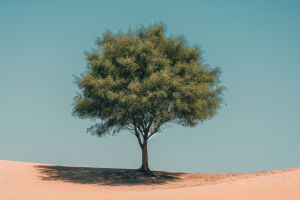On hot days, plants face a critical challenge: conserving water to survive the harsh conditions.
While sunlight and warmth are essential for photosynthesis and growth, excessive heat can lead to rapid water loss through a process called transpiration.
To adapt, plants have developed intricate mechanisms to minimize water loss while maintaining essential functions. Let's explore the fascinating strategies plants employ to conserve water, from structural adaptations to biochemical processes, highlighting their resilience in even the most arid environments!
1. Stomatal Regulation: The Key to Water Control
Stomata are tiny pores on the surface of leaves that play a crucial role in regulating water loss.
• How It Works: Stomata open to allow the exchange of gases, enabling photosynthesis. However, they close during high temperatures to reduce water loss.
• Guard Cells: Specialized cells surrounding each stoma control its opening and closing. During hot days, guard cells lose turgidity, causing the stomata to close.
• Example: Desert plants like cacti exhibit this behavior effectively, keeping stomata closed during the day and opening them at night (a process known as CAM photosynthesis).
2. Waxy Cuticle: A Protective Shield
The waxy cuticle is a layer of lipid-based material covering the surface of leaves and stems.
• Function: It acts as a barrier to water evaporation, reflecting sunlight and reducing heat absorption.
• Thickness Variations: Plants in arid regions often have thicker cuticles to maximize water conservation.
• Example: The oleander plant has a thick, shiny cuticle that minimizes water loss even under intense sunlight.
3. Leaf Adaptations: Size and Structure
Plants modify their leaf size and structure to reduce water loss.
• Small or Reduced Leaves: Smaller leaves have less surface area, reducing the amount of water lost through transpiration. Some plants, like cacti, replace leaves with spines.
• Leaf Orientation: Some plants orient their leaves vertically to reduce exposure to direct sunlight.
• Example: Grasses in savannas have narrow, rolled-up leaves that trap moisture and reduce water loss.
4. Root System Efficiency
The root system plays a vital role in accessing and conserving water.
• Deep Roots: Plants with deep root systems can tap into underground water reserves.
• Shallow, Widespread Roots: In contrast, some plants spread their roots close to the surface to quickly absorb rainwater before it evaporates.
• Example: Mesquite trees develop taproots that extend over 50 feet to access deep water sources.
5. Trichomes and Hairy Leaves
Trichomes are tiny hair-like structures on the surface of leaves and stems.
• Role in Water Conservation: They create a microenvironment that reduces air movement near the leaf surface, slowing down evaporation.
• Additional Benefits: Trichomes reflect sunlight, reducing leaf temperature and water stress.
• Example: Lamb’s ear has thick, fuzzy leaves covered in trichomes to conserve moisture.
How Plants Conserve Water
Video by MishL129Lee
By understanding these mechanisms, we can appreciate the resilience of plants and explore ways to cultivate more drought-resistant species, crucial for sustainable agriculture and conservation in a warming world!


